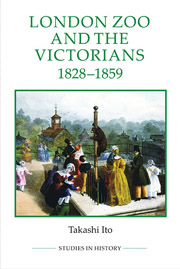Book contents
- Frontmatter
- Contents
- List of figures
- List of tables
- Acknowledgements
- Abbreviations
- Dedication
- Introduction: the zoo in history
- 1 The site of animal spectacle
- 2 Collecting and displaying
- 3 The question of access
- 4 Between science and commerce
- 5 Illusionary empire
- Conclusion: the Darwinian moment
- Appendix
- Bibliography
- Index
1 - The site of animal spectacle
Published online by Cambridge University Press: 05 April 2014
- Frontmatter
- Contents
- List of figures
- List of tables
- Acknowledgements
- Abbreviations
- Dedication
- Introduction: the zoo in history
- 1 The site of animal spectacle
- 2 Collecting and displaying
- 3 The question of access
- 4 Between science and commerce
- 5 Illusionary empire
- Conclusion: the Darwinian moment
- Appendix
- Bibliography
- Index
Summary
‘Like too many of our modern associations and companies, this is extremely sonorous on paper; but alas for the execution of the design – is it not alto-gether visionary? Yet we understand it is patronised by some very influential men; and no one could be sorry to see the experiment tried.’
The London Zoo is in the same place today as it was nearly two centuries ago. On a current map of Greater London, it occupies a tiny triangle, sandwiched between the spacious grounds of Regent's Park and Primrose Hill, and seems to fit naturally into its surroundings. This was not the case, however, when plans for a zoo began to be made in the late 1820s. For its contemporaries the construction of the zoo was a new social experience. London had already played host to animal spectacles such as the Exeter Exchange Menagerie, the Tower of London Menagerie and Smithfield Market, but the scale envisaged for the new zoo's collection as well as the space in which it was exhibited was incomparable. The London Zoo was innovatory in topographical terms too. It was well away from the crowded areas of the city and was surrounded by the picturesque landscape of Regent's Park. However, judging from the scale and location of the zoo, its construction appeared to be a speculative rather than promising venture.
- Type
- Chapter
- Information
- London Zoo and the Victorians, 1828-1859 , pp. 21 - 52Publisher: Boydell & BrewerPrint publication year: 2014

